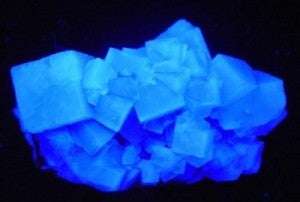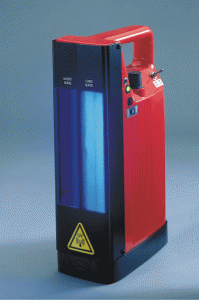Loading... 24 view(s)
The first person to observe fluorescence in minerals was George Stokes in 1852. He noted the ability of fluorite to produce a blue glow when illuminated with ultraviolet light and called this phenomenon "fluorescence" after the mineral fluorite.
The name became synonymous with metallurgists, gemologists and biologists.
[caption id="attachment_9448" align="aligncenter" width="300"] Fluorite[/caption]
Lamps for viewing florescent Minerals
Lamps used to visualise seams of fluorite and other fluorescent minerals are commonly used in mines but they tend to be on an industrial scale. The lamps need to be short wavelength to be useful for this purpose and of scientific grade. A recent customer request for a UV lamp identified the UVP range of hand held UV lamps ideal for this purpose and used by Geologists to identify the best sources of fluorite in mines or potential new mines.
Camlab have a wide range of UV lamps available and the one we recommend for Geological use is the UVP UVSL-26P.
[caption id="attachment_9450" align="aligncenter" width="199"]
Fluorite[/caption]
Lamps for viewing florescent Minerals
Lamps used to visualise seams of fluorite and other fluorescent minerals are commonly used in mines but they tend to be on an industrial scale. The lamps need to be short wavelength to be useful for this purpose and of scientific grade. A recent customer request for a UV lamp identified the UVP range of hand held UV lamps ideal for this purpose and used by Geologists to identify the best sources of fluorite in mines or potential new mines.
Camlab have a wide range of UV lamps available and the one we recommend for Geological use is the UVP UVSL-26P.
[caption id="attachment_9450" align="aligncenter" width="199"] UVP UV Lamp Dual Wavelength[/caption]
UVP UV Lamp Dual Wavelength[/caption]
Main Features
- Rechargeable Lamps have two tubes for added UV intensity
- Model UVSL-26P shown can operate with both longwave and shortwave on at the same time
- Rechargeable lamps are equipped with an internal gel-based, lead-acid battery which can be charged for field operation from a standard wall outlet
- A 12V adapter is available for operating the lamp from a car cigarette lighter
- 254nm or 365nm
- 6 watts power
- 6V batteries or ac supply
- Dims 249mmL x 76mmW x 140mmH






